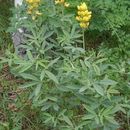en
names in breadcrumbs


Thermopsis rhombifolia, also known as prairie thermopsis,[1] is a flowering plant in the legume family. It is native to North America, where it is found in the Great Plains, with extensions into the lower canyons of the Rocky Mountains. Its natural habitat is dry grasslands and woodlands.[2][3]
It is a perennial herb that produces yellow flowers in the spring.[4]
The flowers were commonly used by the natives as a source of yellow dye and were boiled in a tea as a cure for stomach ailments for people and horses. The plant has toxic properties if ingested; symptoms of poisoning include vomiting, dizziness, and abdominal pain.[5]
![]() Media related to Thermopsis rhombifolia at Wikimedia Commons
Media related to Thermopsis rhombifolia at Wikimedia Commons
Thermopsis rhombifolia, also known as prairie thermopsis, is a flowering plant in the legume family. It is native to North America, where it is found in the Great Plains, with extensions into the lower canyons of the Rocky Mountains. Its natural habitat is dry grasslands and woodlands.
It is a perennial herb that produces yellow flowers in the spring.